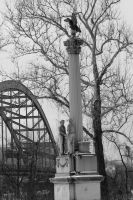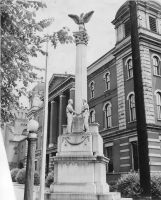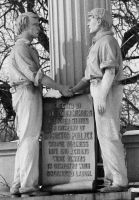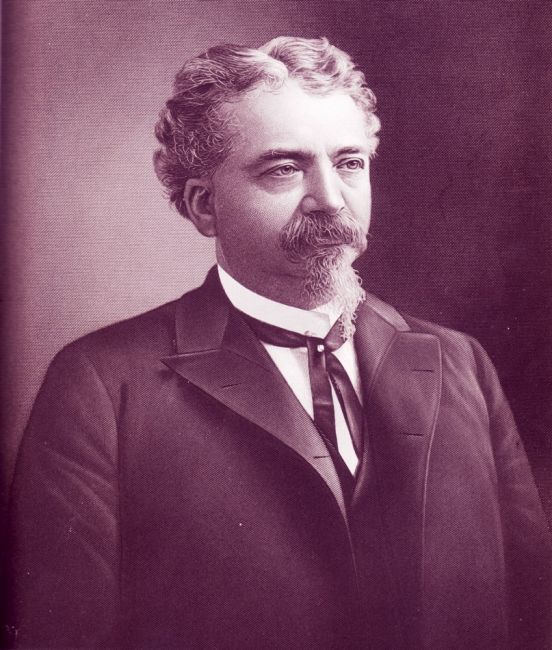
Biography: Augustus Pollack
The Stogie King
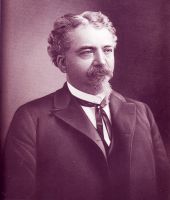 Augustus Pollack (1830-1906) established a notions and fancy goods business in Wheeling in 1854. A German Jew, Pollack was an active member of Wheeling’s large German immigrant community. He helped establish a German American volunteer company during the Civil War and later a German language newspaper. He also helped raise money for the widows and orphans of German soldiers killed in the Franco-Prussian War (1870-71). Pollack served on the board of Wheeling Library Association (precursor to the Ohio County Public Library) and was named president of Wheeling’s 1885 Saengerfest (a German singing festival).
Augustus Pollack (1830-1906) established a notions and fancy goods business in Wheeling in 1854. A German Jew, Pollack was an active member of Wheeling’s large German immigrant community. He helped establish a German American volunteer company during the Civil War and later a German language newspaper. He also helped raise money for the widows and orphans of German soldiers killed in the Franco-Prussian War (1870-71). Pollack served on the board of Wheeling Library Association (precursor to the Ohio County Public Library) and was named president of Wheeling’s 1885 Saengerfest (a German singing festival).
Founded in 1871, Pollack’s signature business, Crown Stogies, grew to become West Virginia’s largest cigar manufacturer. When built, his factory spanning 18th and 19th Streets from Chapline to Eoff was one of the largest cigar factories in the world. In his 1906 obituary, the Wheeling News-Register declared, “no one deserves more credit for the Wheeling stogie’s prestige.”
Pollack did not ask or expect more of his employees than he did of himself. He paid them well for the period, and maintained an open door policy regarding employee concerns over work conditions, hours, and wages – an unusually progressive attitude for a nineteenth century entrepreneur. While his contemporaries in steel and coal faced regular and often violent struggles over labor issues, Pollack’s employees remained comparatively loyal and content. His policies influenced other local stogie manufacturers. Pollack refused, as he pondered retirement, to sell his factories to buyers who would not honor the pact he had made with his employees regarding their labor concerns.
After his April 23, 1906 death, The Ohio Valley Trades and Labor Assembly called a special meeting to
encourage all the members of local trade unions to attend Pollack’s funeral. The pall-bearers were chosen from his employees, who, along with their union brethren, publicly demonstrated their affection for him in an unusual manner. The Garfield Assembly of International Stogie Makers spearheaded a collection of donations to erect a large monument in Pollack’s honor. Depicting a handshake between employee and employer, the monument was placed in a prominent position on the grounds of Wheeling’s city building. It was later moved to Main Street near the Fort Henry Bridge. In 2013, the monument was relocated to Wheeling's Heritage Port.
Inscribed: "Erected by Trade Union Members of United States in Memory of Augustus Pollack Whose Business Life and Actions Were Always in Sympathy with Organized Labor,“ it is thought to be the only monument ever built by labor in honor of a business owner. (Seán Duffy for Legendary Locals of Wheeling)
Read Augustus Pollack's Wheeling Hall of Fame biography.
Pollack Monument
- Dedicated May 28, 1916
Monument on the Move
Statue honoring Crown Stogies founder relocated to Wheeling's Heritage Port
By Rebecca Olsavsky, Staff Writer
The monument honoring the founder of Crown Stogies has been relocated.
Previously located on Main Street near the Fort Henry Bridge on-ramp the Pollack monument now stands at Wheeling Heritage Port. After mortaring it into place, workers expect the relocation to be complete by the end of the day today. Then, the restoration process will begin.
Named for Augustus Pollack, a Wheeling business-owner in the late 19th and early 20th centuries, the monument was first dedicated in 1916.
According to project manager Mike Major, the monument, depicting an employee and employer shaking hands, represents an ideal of business practice.
"It celebrates the potential of a good relationship between management and unions." Major explained "Unions, by their own expense, paid tnbute to a wonderful man. "
Known for treating employees with respect. Pollack worked 16-hour days and maintained an open door policy in terms of employee concerns Pollack’s business. Crown Stogies, became West Virginia’s largest cigar manufacturer
An inscription on the monument reads, "Erected by trade union members of United States in memory of Augustus Pollack whose business life ana actions always in sympathy with organized labor.”
Major, who resides in Urbana, Ohio, is primarily a sculptor but has restoration expenence He said volunteers have taken a part in helping with the relocation.
"I'm glad to have the opportunity to see tne Wheeling community,' Major said "People here are humble, talented and bright.’’
Major was invited to work on the relocation and restoration after Wheeling Heritage Port was deemed a better location for the monument He said restoration will include, patching, placing broken chips back into place and cleaning surfaces the best we can."
The Pollack monument is granite and weighs 60,000 pounds
To View The Complete Article CLICK HERE
POLLACK MONUMENT DEDICATED BY WORKERS OF OHIO VALLEY
THOUSANDS PARADE STREETS OF CITY
Touching Tribute Is Paid to Deceased Employer By Labor Organizations ofTri-State District.
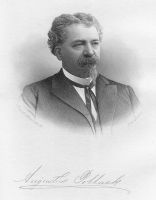 Ten thousand workers of the tri-state district turned out in a gigantic labor memorial parade yesterday afternoon and paid a glowing tribute to the memory of the late Augustus Pollack. The parade was followed by the unveiling of the Pollack monumental memorial shaft at the public square, which was witnessed by thousands of men and women of all walks of life. The employer and the employe joined hands in the bond of comradeship and each and every thought was that of paying a tribute to the memory of the man who has done much to put labor on the high plane which it enjoys in the Wheeling district.
Ten thousand workers of the tri-state district turned out in a gigantic labor memorial parade yesterday afternoon and paid a glowing tribute to the memory of the late Augustus Pollack. The parade was followed by the unveiling of the Pollack monumental memorial shaft at the public square, which was witnessed by thousands of men and women of all walks of life. The employer and the employe joined hands in the bond of comradeship and each and every thought was that of paying a tribute to the memory of the man who has done much to put labor on the high plane which it enjoys in the Wheeling district.
The parade started from the public square at 2 o'clock, and moved south to Sixteenth to Market, to Ninth to Main to Twentieth, to Sixteenth to Chapline and back to the public square. The majority of the labor hosts were on foot and but a few automobiles were in the parade. The machines contained the city and county officials.
The first division was headed by Chief Thomas Leyland and an escort of thirty two uniformed police officers, followed by a squad of firemen in uniform in charge of Chief Edward T. Rose. The Pollack Monumental memorial committee composed of H. P. Corcoran, Mike Mahoney, John G. Minkemeyer, W. F. Welch and Henry B. Wessel, followed on foot, while next in line was the Ohio Valley Trades and Labor Assembly.
Following was an automobile occupied by Architect Fred Faris, contractor Kreutzer,J. B. Handlan, member of the board of county commissioners, Louis Haller, John Garden, Charles Ephlin and George Oldham were in the second machine and Mayor H. L. Kirk, of the city of Wheeling, C. Hal Brues, Henry Wesigaber and others were in the next.
Meister's brass band of thirty-two pieces followed, with Local 501 of Stogiemakers, three hundred strong next in line. Others following in rotation were Cigar makers 409, tobacco workers No. 2, strippers, No. 2, Federal Union of Tobacco Workers, Potters' Local No. 6, Potters' No. 28 and Potters' No. 46.
Second division: Greater Wheeling Band, Flint Glass Workers, No. 9, Flint Glass Workers No. 59 of Moundsville, Mould Makers, A. F. G. U. No. 53, Glass Cutters A. F. G. U., No. 58, Glass Bottle Blowers Branch No. 109; Plasters Union No. 39 and Painters Local No. 91.
Third Division: Rauch's Band, Crescent Lodge No. 8, A. A. of I. S. T. W.,Belmont Lodge No. 46, A. A. of I. S. T. W., Manchester Lodge No. 12, A. A. ofI. S. T. W., Street Car Union No. 103, Butchers' Local No. 7, Barbers Local No.257, Tailors' Local no. 246, Leather Workers' Union No. 60, United Mine Workers' Union No. 1229, Can Workers' Union.
Fourth Division: Warwood Band, Carpenters' Local No. 3, Carpenters' Local No. 1217, Carpenters' Local No. 1604, Carpenters' No. 170, Carpenters' No.1568, Carpenters' No. 17, Tile Layers' Union No. 86, Cement Finishers' Union No. 517 and Amalgamated Hod Carriers.
Fifth Division: McMechen Band, Machinists' Local no. 845, Machinist Local No. 818, Moulders' Local No. 264, Engineers' No. 21, Structural Iron Workers'No. 20, Plumbers' No. 83, Dilles Bottom Local of United Mine Workers of America, Sheet Metal Workers No. 131, Steubenville, Ohio Locals, Electrical Workers No. 141, Modern woodman drum and bugle corps, Theatrical Employes,Electrical Workers No. 277, Brewery Workers, Casket Makers, Elks' Band ofBellaire, O., Cement Workers, Brick Layers Union, Carriage Makers, Automobile Machinists, Stephen's Band of McMechen.
A number of out-of-town men in the city and staff photographers were busy all along the line of march. The streets were lined with people and the windows of the various stores were also crowded with throngs that turned out to witness the great labor memorial demonstration. Many automobiles occupied the side streets and the procession was witnessed from that point of view by many.
The memorial meeting was called to order by Michael Mahoney, chairman of the Pollack memorial committee, who paid a tribute to the memory of the deceased employer of labor and told of the great esteem in which his memory is held by the workers of all trades in the Ohio Valley, where many of them were associated directly, or indirectly with him. He stated that the late Augustus Pollack needed no monument to call his memory to he attention of the workers of today, but he said when you and I have crossed the Great Divide there will be others who will linger in front of the Pollack memorial shaft and remark, "He Was A Friend of Labor," which meant to Mr. Pollack the workers of all classes.
The speaker paid a compliment to the Hon. J. Bernard Handlan who as counsel for the memorial committee had assisted them in many ways and although he was employed for a period extending over ten years, he refused to accept a penny of compensation for his services. The city and county officials including the prosecuting attorney, the mayor, members of the board of county commissioners,and others were also thanked by the speaker for the part that they have taken in securing the site and for the placing of the shaft. Mr. Mahoney next introduced as the chairman of the meeting, Louis Leonard, president of the Ohio Valley Trades and labor Assembly, who took charge.
The speaker spoke in part as follows: True goodness is not marked by wealth,but that the hand of fellowship and comradeship can often be of more service than dollars and cents in every-day life. Give the worker a fair wage,respectable working conditions, and reasonable hours and he will not ask for any favors. The late Augustus Pollack was such a man and he always considered his employes first, last and always. He believed that in assisting them, he was also assisting himself and made an effort to keep the standard of his workers on a plane where they would not be ashamed to associate with the very best people,as they were an equal and a part of all. May the memory of the late Augustus Pollack always stand as an example to others to lead an honest, upright and clean life.
Originator of Monument.
The chairman next introduced George Keyser, the originator of the idea of erecting a monument to the late Augustus Pollack. He was employed by the late Augustus Pollack and was also a member of the Ohio Valley Trades and Labor assembly, and was while a member of that body that he succeeded in having a resolution passed which created the Pollack memorial committee that was instrumental in placing the monument in the city. Mr. Keyser arose and made a few remarks to the audience and was applauded as he seated himself.
Harry P. Corcoran.
Harry P. Corcoran, to whom great credit is to be given for the part that he has taken in the erection of the monument, was next introduced and stated that he would give a few facts and figures on the financial end of the Pollack monument. The total cost of the monument was $6,925, while the total expense was $8,433.10. The largest contribution was by a local union in the sum of $500. The largest sum from any individual was $100 and the smallest was 25 cents.
Six international unions contributed, 750 local unions and central bodies contributed,and 3,000 individuals contributed. The memorial committee met with the Ohio Valley Trades and Labor assembly yesterday morning and turned over the sum of $41.65 to that body and also the Pollack memorial shaft which will be kept up by labor in the future. Mr. Corcoran stated that it was one of his ambitions to witness the unveiling of the monument and that it had been realized.
He paid a compliment to the persons and unions that had contributed to the fund and thereby made possible the erection of the big memorial shaft. He urged that the members of the working class rivet their eyes on the memory of the deceased and in the days to come try to keep in mind one who had done so much for the workers of the Ohio valley and the Wheeling district. He also paid a touching tribute to the memory of the late L. W. Selvey, who he stated had always expressed the desire to be present at the unveiling services.
Michael F. Tighe
The principal speaker of the day was Michael F. Tighe, secretary-treasurer of the Amalgamated Association of Steel and Sheet Metal Workers of America, of Pittsburgh,Pa. The speaker is a former resident of this city and stated in his opening remarks that he was a personal friend of the late Augustus Pollack and therefore well able to speak of his life and his worldly deeds. In part he spoke as follows:
"The path of glory leads but to the grave" was the theme from which the speaker chose his subject, and he told of the life of the deceased being along that path of glory. The religion of the late Augustus Pollack was the wide world. He believed in doing unto others as he would be done by, and throughout his life on earth he followed that slogan and lived an upright and honest life that should be a model for every man to follow.
Augustus Pollack's Official Hall of Fame Biography
1830-1906
Business, Industry and Professions
Inducted 2013
“Work wins” Augustus Pollack once wrote, a simple, two-word motto that came to define the Wheeling businessman’s life and career.
Augustus Pollack was born in Germany on July 5, 1830 to a reasonably well-to-do farming family. Augustuswas educated at Buende College and apprenticed at a large commercial house until political upheaval and the prospect of military conscription prompted the 18-year-old to immigrate to the United States. He first settled in Baltimore, establishing a notions and fancy goods business, which he moved to Wheeling in 1854. Pollack married Rosalie Weinberg of Baltimore in 1855 (they had one son and six daughters) and established another business in Graft on in 1858. Pollack moved to Wheeling permanently in 1860 and lived with his family above his Main Street business. He resided in Wheeling for the next 46 years until his death on April 23, 1906.
Pollack served on the board of education and as an elector on Republican Benjamin Harrison’s presidentialticket. A devoted Unionist during the Civil War, Pollack allowed the U.S. military to use his Graft on buildings without charge for the war eff ort, prompting a letter of gratitude from Secretary of War Simon Cameron. Pollack helped establish a German American volunteer company, and helped bring the Pittsburgh, Cincinnati & St. Louis Railroad into Wheeling.
A German Jew, Pollack was an active member of Wheeling’s German immigrant community, helping to establish a German language newspaper, “The Patriot,” and serving for a time as president of both the German Bank and German Fire Insurance Companies. Pollack was named honorary president of the 1885 Saengerfest, a large German singing festival and, in 1870, helped raise money for the widows and orphans of German soldiers killed in war. Pollack also served as Director of the Linsly Institute as well as trustee of the Female College and was a generous patron of the arts, particularly classical music.
Pollack founded his signature business, Crown Stogies, on Water Street in East Wheeling in 1871. In just 15 years, Crown Stogies grew to become West Virginia’s largest cigar manufacturer. At their peak, his two factories employed more than 500 people. When built, his factory spanning 18th and 19th Streets from Chapline to Eoff was one of the largest cigar factories in the world. In his 1906 obituary, the Wheeling News-Register declared that no one deserved “more credit for the Wheeling stogie’s prestige.”
Known to work 16-hour days at his office on Water Street, Pollack did not ask more of his employees than he did of himself. He paid them well and maintained an open door policy regarding employee concerns over work conditions, hours, wages — an unusually progressive attitude for a nineteenth century entrepreneur. Thus, while his contemporaries in steel and coal faced regular and often violent labor struggles, Pollack’s employees remained comparatively loyal and content. His policies influenced other local stogie manufacturers, rendering stogie-making Wheeling’s most desirable career choice for the working class.
Pollack’s employees and their local union brethren publicly demonstrated their affection for him in an unprecedented manner. After he died on April 23, 1906, local labor unions, led by the Garfield Assembly of International Stogie Makers, collected donations from their membership to erect a large monument in Pollack’s honor. Depicting a handshake between employee and the employer, the monument was placed in a prominent position on the grounds of Wheeling’s city building. It was later moved to its current home on Main Street near the Fort Henry Bridge on-ramp. [Note: It has since been moved to Heritage Port.]
The inscription reads: “ERECTED BY TRADE UNION MEMBERS OF UNITED STATES IN MEMORY OF AUGUSTUS POLLACK WHOSE BUSINESS LIFE AND ACTIONS ALWAYS IN SYMPATHY WITH ORGANIZED LABOR.” The Pollack monument is thought to be the only memorial ever built by labor in honor of a business owner.
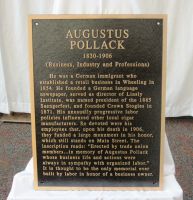 Read Pollack's WHOF induction speech [Word doc].
Read Pollack's WHOF induction speech [Word doc].
Read the induction program page [pdf doc].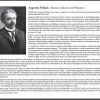
Biographies Index | Wheeling Hall of Fame Index | Wheeling History Home | OCPL Home









